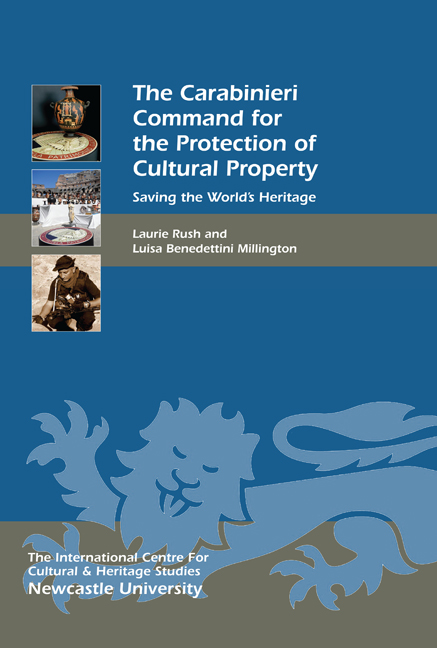Book contents
- Frontmatter
- Contents
- List of Illustrations
- Acknowledgments
- Foreword (in English and in Italian): Brigadier General Mariano Mossa
- Prefazione
- Abbreviations
- 1 The Carabinieri TPC: an Introduction and Brief History. Perché l’Italia? Why Italy?
- 2 Headquarters, the Databank and Operative Department in Rome
- 3 Carabinieri Public Outreach and Education
- 4 Central Italy and the Adriatic: Lazio, Florence, Bologna and Ancona
- 5 Activities in the North: Genova, Monza, Torino and Venezia
- 6 The Regional Offices: Naples, Bari and the South
- 7 The Challenges of the Island Regions: Sicily, Sardinia and the Palermo, Siracusa and Sassari Nuclei
- 8 Investigation Techniques
- 9 Repatriation of Works of Art to Italy: From Siviero to the Medici Conspiracy
- 10 Fakes, Forgeries and Money Laundering
- 11 Who Are the Officers of the Carabinieri TPC?
- 12 The Carabinieri, Peacekeeping and Foreign Relations: The Carabinieri Mission to Iraq
- 13 ‘The Italian Model’
- Bibliography and References
- About the Authors
- Index
- Heritage Matters
8 - Investigation Techniques
Published online by Cambridge University Press: 21 May 2021
- Frontmatter
- Contents
- List of Illustrations
- Acknowledgments
- Foreword (in English and in Italian): Brigadier General Mariano Mossa
- Prefazione
- Abbreviations
- 1 The Carabinieri TPC: an Introduction and Brief History. Perché l’Italia? Why Italy?
- 2 Headquarters, the Databank and Operative Department in Rome
- 3 Carabinieri Public Outreach and Education
- 4 Central Italy and the Adriatic: Lazio, Florence, Bologna and Ancona
- 5 Activities in the North: Genova, Monza, Torino and Venezia
- 6 The Regional Offices: Naples, Bari and the South
- 7 The Challenges of the Island Regions: Sicily, Sardinia and the Palermo, Siracusa and Sassari Nuclei
- 8 Investigation Techniques
- 9 Repatriation of Works of Art to Italy: From Siviero to the Medici Conspiracy
- 10 Fakes, Forgeries and Money Laundering
- 11 Who Are the Officers of the Carabinieri TPC?
- 12 The Carabinieri, Peacekeeping and Foreign Relations: The Carabinieri Mission to Iraq
- 13 ‘The Italian Model’
- Bibliography and References
- About the Authors
- Index
- Heritage Matters
Summary
Having successfully demonstrated to the world that prominent US museums had been purchasing stolen objects from Italy, and following successful repatriation of those objects, the Carabinieri TPC has established a well-deserved global reputation for its investigation methods. For a sense of the scale of the success of the Carabinieri TPC in terms of art recovered, consider the following statistics: between 1970 and 2007, the Carabinieri recovered 202,924 works of art including 8032 found in and repatriated from other countries; 1268 art objects with origins in other countries, discovered in Italy and returned to their country of origin; and over 250,000 fake objects seized by the counterfeiting section (Purarelli 2007) (see Fig 8.1).
As exciting as it is to focus on the aspects of Carabinieri TPC investigative activities that are reminiscent of James Bond films – car chases and agents rappelling out of helicopters in a remote Iraqi desert – the success of the Carabinieri TPC is overwhelmingly due to professional competence, experience, attention to detail, patience, persistence and international legal expertise, plus an ability to partner with subject matter experts and other authorities. These skills apply to solving all types of art crime, whether involving stolen works of art, looted archaeological objects or forgeries. If we think of investigation in terms of essentials, these would include the collection of solid and incontrovertible evidence of guilt on the part of the criminals; identification of locations or hiding places for stolen objects; incrimination of dealers, receivers or buyers; and evidence linking them to the stolen objects.
The Carabinieri TPC's success is even more impressive when one considers the criminal behaviour they encounter. Thieves who focus on works of art represent the type of individual who is willing to steal objects from churches, to cut up sacred paintings and altarpieces and transform baptism fonts into ornamental fountains, confessionals into bars or bookcases, candelabra into table lamps, censers into chandeliers, sacristies into armoires and tabernacles into drinks cabinets. There are tombaroliwilling to destroy ancient tombs, scattering human remains across the countryside while helping themselves to the jewels of the deceased, and gallery owners who are more than happy to consciously sell forged works of art as authentic to unsuspecting collectors.
- Type
- Chapter
- Information
- The Carabinieri Command for the Protection of Cultural PropertySaving the World's Heritage, pp. 111 - 126Publisher: Boydell & BrewerPrint publication year: 2015



